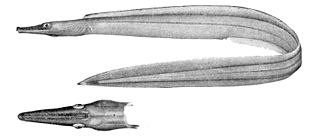
Nettastomatidae, the duckbill eels or witch eels are a family of eels. The name is from νῆττα and στόμα.

Gymnothorax is a genus of fish in the family Muraenidae found in Atlantic, Indian, and Pacific Oceans. With more than 120 species, it the most speciose genus of moray eels.

Uropterygius is a genus of moray eels in the family Muraenidae.

Heteroconger is a genus of marine congrid eels. These small, slender garden eels live in groups where each individual has its own burrow. Usually, only the head and front half of the body is visible. The greatest species richness is in the Indo-Pacific, but species are also found in the warmer parts of the Atlantic and the eastern Pacific. Its name relates to how a huge colony of the eels looks swaying in the current.

The blackfin sorcerer is a species of saltwater eel in the family Nettastomatidae of the order Anguilliformes. It is found only in the Atlantic Ocean and the Mediterranean Sea.

Eels are ray-finned fish belonging to the order Anguilliformes, which consists of eight suborders, 20 families, 164 genera, and about 1000 species. Eels undergo considerable development from the early larval stage to the eventual adult stage and are usually predators.
Bathycongrus is a genus of eels in the family Congridae.

Nettenchelys is a genus of eels in the duckbill eel family Nettastomatidae.
Saurenchelys is a genus of eels in the duckbill eel family Nettastomatidae.
Neenchelys is a genus of snake eels native to the Indian Ocean and the western Pacific Ocean. All species of Neenchelys have two rather than three preopercular pores, a significant character among many species of ophichthids.

Protanguilla palau is a species of eel, the only species in the genus Protanguilla, which is in turn the only genus in its family, Protanguillidae. Its common name is Palauan primitive cave eel. Individuals were found swimming in March 2010 in a deep underwater cave in a fringing reef off the coast of Palau.

The duck-billed eel, also known as the shortsnouted sorcerer or the smallhead duckbill eel, is an eel in the family Nettastomatidae. It was described by Albert Günther in 1877. It is a marine, deep water-dwelling eel, which is known from the Indo-Pacific and the southeastern Pacific Ocean, including Japan, Hawaii, eastern Australia, southeastern Africa, and Chile. It dwells at a depth range of 60–1190 metres, and inhabits the continental shelf and slope. Males can reach a maximum total length of 83 centimetres.
The solitary duckbill eel is an eel in the family Nettastomatidae. It was described by Peter H. J. Castle and David G. Smith in 1981. It is a marine, deep-water-dwelling eel which is known from the Indo-Western Pacific, including Kyushu–Palau Ridge, the Philippines, Australia, and the Hawaiian Islands. It is known to dwell at a depth range of 415 to 610 metres. Males can reach a maximum total length of 46.5 centimetres (18.3 in).
Nettastoma syntresis is an eel in the family Nettastomatidae. It was described by David G. Smith and James Erwin Böhlke in 1981. It is a marine, deep water-dwelling eel which is known from the western central Atlantic Ocean, including the Bahamas, Cuba, and the northeastern Gulf of Mexico. It dwells at a depth range of 0 to 641 metres. Males can reach a maximum standard length of 55 centimeters (22 in).
Nettenchelys exoria is an eel in the family Nettastomatidae. It was described by James Erwin Böhlke and David G. Smith in 1981. It is a marine, deep water-dwelling eel which is known from the western central Atlantic Ocean, including Florida, USA and the Bahamas. It dwells at a depth range of 277 to 494 meters. Males can reach a maximum total length of 46.7 centimeters (18.4 in).
The bridge duckbill eel is an eel in the family Nettastomatidae. It was described by Peter Henry John Castle and David G. Smith in 1981. It is a marine, deep water-dwelling eel which is known from the western Pacific Ocean, including New Caledonia, the Philippines, and Indonesia. It dwells at a depth range of 400–412 metres (1,312–1,352 ft). Females can reach a maximum total length of 43.1 centimetres (17.0 in).
Nettenchelys inion is an eel in the family Nettastomatidae. It was described by David G. Smith and James Erwin Böhlke in 1981. It is a marine, deep water-dwelling eel which is known from a single specimen discovered near North Bimini Marine Protected Area in 1964. It is known to dwell at a depth range of 458 to 531 meters. Males can reach a total length of 42.3 centimeters (16.7 in).
The pygmy pikeconger or pygmy duckbill eel, is an eel in the family Nettastomatidae. It was described by David G. Smith and James Erwin Böhlke in 1981. It is a marine, tropical eel which is known from the western central Atlantic Ocean, including Venezuela and the Gulf of Mexico, and possibly more locations. It is known to dwell at a depth range of 128 to 280 meters. Males can reach a maximum total length of 20.1 centimeters (7.9 in).
The whipsnout sorcerer is an eel in the family Nettastomatidae. It was described by Léon Vaillant in 1888, originally under the genus Nettastoma. It is a marine, deep water-dwelling eel which is known from tropical, subtropical and temperate areas throughout the world. It dwells at a depth range of 385 to 2,200 metres, and inhabits the lower region of the continental slope. Males can reach a maximum total length of 100 centimetres (39 in).

Venefica procera is an eel in the family Nettastomatidae. It was described by George Brown Goode and Tarleton Hoffman Bean in 1883, originally under the genus Nettastoma. It is a marine, deep water-dwelling eel which is known from the western central Atlantic Ocean, including North Carolina, USA, Suriname, the Gulf of Mexico and the Caribbean Sea. It dwells at a depth range of 326 to 2,304 meters. Males can reach a maximum total length of 109 centimeters (43 in).










